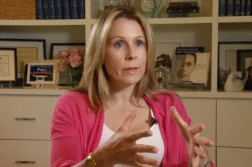JACKSONVILLE, Fla. (Ivanhoe Newswire) – More than 310,000 women in the U.S. will be diagnosed with breast cancer this year – that averages to about one in eight women. With early detection and advanced treatments, breast cancer is now one of the most survivable cancers. Mammograms are the gold standard for screening, but they’re not perfect. Now, there’s a new screening tool that’s helping detect tumors mammograms miss! Hard-to-find
“My breast cancer had metastasized to my liver,” says Sandy Cassanelli, a breast cancer patient.
Jose Barbot says, “My mom died of breast cancer when she was 46. I was 21.”
“When you’re initially given the diagnosis, your focus is on survival,” Jane Obadia, a breast cancer survivor, says.
Although every woman’s story is different, all agree early detection is key. For 40 percent of women over 40 in the U.S., a mammogram is not enough when it comes to finding it.
“Some lesions or tumors can hide in the dense tissue, and it may not show up as clearly on a mammogram when women have dense breasts,” explains Laila Samiian, MD, breast surgeon at Baptist MD Anderson Cancer Center in Jacksonville, Florida.
Mammograms miss about 20 percent of cancer during screening. Now, a new tool called ABUS is giving doctors a clearer picture of hard-to-find- breast cancer.
Dr, Samiian further explains, “Whole breast ultrasound just, kind of, looks at the whole breast, so it just, kind of, scans across your whole breast up and down.”
Breast radiologists have women lie on their backs. The ABUS presses down on the chest wall. High frequency sound waves capture precise 3D images. For every one thousand patients getting an ABUS exam, one to two more cancers are found than with mammography alone. But Dr. Samiian stresses, it’s not a replacement for mammograms.
“There are things that the ultrasound will pick up that the mammogram won’t, and there are things that the mammogram will pick up that the ultrasound won’t,” Dr. Samiian adds.
The entire process takes about 30 minutes — time that could end up saving your life.
“Early detection saves lives. I am living proof of that,” says breast cancer survivor, Michelle Brubaker.
Another advantage – images taken with ABUS can be reproduced yearly to help with comparing tissue changes from year to year.
Contributors to this news report include: Marsha Lewis, Producer; Matt Goldschmidt, Videographer & Editor.
To receive a free weekly e-mail on medical breakthroughs from Ivanhoe, sign up at: http://www.ivanhoe.com/ftk
Source:
MEDICAL BREAKTHROUGHS
RESEARCH SUMMARY
TITLE: FINDING HARD-TO-FIND BREAST CANCER
REPORT: MB #5353
BACKGROUND: Breast cancer is a type of cancer that forms in the cells of the breasts. It is the most common cancer diagnosed in women worldwide, though it can also affect men, albeit much less frequently. Breast cancer can occur in different areas of the breast, including the ducts that carry milk to the nipple (ductal carcinoma), the glands that produce milk (lobular carcinoma), or in other tissues within the breast. According to the American Cancer Society, there are over 310,000 new cases of breast cancer diagnosed in women, and over 42,000 will die from it. Having dense breast tissue is also an issue for women and can increase their risk of breast cancer – about 10% of women have dense breasts. Younger women, pregnant or breastfeeding women, those taking hormone replacements, and women with lower body weight are more likely to have dense breasts.
(Sources: https://www.mayoclinic.org/diseases-conditions/breast-cancer/symptoms-causes/syc-20352470
https://www.cancer.org/cancer/types/breast-cancer/about/how-common-is-breast-cancer.html
https://www.cdc.gov/cancer/breast/basic_info/dense-breasts.htm)
DIAGNOSING: Symptoms of breast cancer include, but are not limited to: a lump in the breast or thickening of skin in that area, the nipple looks flattened or goes inward, changes in breast skin color, changes in size, shape, or appearance of breast, and/or peeling, scaling, crusting, or flaking on the skin of the breast. Doctors usually diagnose breast cancer with a breast exam, mammogram, breast ultrasound, breast MRI, or a biopsy. Doctors can determine the stage of the cancer through blood tests, bone scans, CT scans, MRIs, or a PET scan.
(Sources: https://www.mayoclinic.org/diseases-conditions/breast-cancer/symptoms-causes/syc-20352470
https://www.mayoclinic.org/diseases-conditions/breast-cancer/diagnosis-treatment/drc-20352475)
NEW TECHNOLOGY: Sometimes, mammograms miss things, especially in dense breasts. A new device used at the Baptist MD Anderson Cancer Center in Jacksonville, Florida, called ABUS, is catching things that mammograms miss in dense breasts. ABUS stands for Automated Breast Ultrasound System, and it catches about 30% more cancers in women with dense breasts. “With 3D ultrasound volume and U-Systems software, radiologists can review hundreds of breast tissue image ‘slices’ to look at layers of dense tissue to find breast cancers which may have been missed on a mammogram.”
FOR MORE INFORMATION ON THIS REPORT, PLEASE CONTACT:
Emily Sharpe Wesley Roberts
Emily.sharpe@bmcjax.com Wesley.roberts@bmcjax.com
If this story or any other Ivanhoe story has impacted your life or prompted you or someone you know to seek or change treatments, please let us know by contacting Marjorie Bekaert Thomas at mthomas@ivanhoe.com




